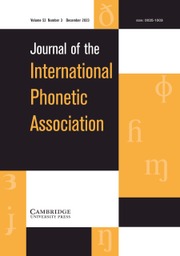Article contents
An articulatory examination of word-final flapping at phrase edges and interiors
Published online by Cambridge University Press: 16 June 2005
Abstract
Formulations of flapping as a symbolic phonological rule suggest clear articulatory differences between flaps and stops, and often offer no overt explanation for why phrase boundaries should block the alternation. The present study explores the articulatory foundation of the distinction between flaps and non-flaps in word-final position. We examine kinematic and acoustic data for these articulations in phrase-final and phrase-medial positions and in falling- and level-stress contours. It is shown that a discrepancy exists between acoustic and articulatory durational patterning – while acoustic durations of flaps are shorter than those of non-flaps overall, their articulatory durations are not uniformly so. It is important to consider multiple potential articulatory sources – both spatial and temporal – for the acoustic shortness that characterizes flaps, including spatial reduction, temporal articulatory shortening, and changes in intergestural coordination. The kinematic data indicate that different sources of word-final flap shortness exist for different speakers and different prosodic conditions, suggesting that gradient variability in the spatiotemporal patterning of tongue-tip constrictions yields acoustic shortening in word-final flaps.
- Type
- Research Article
- Information
- Copyright
- © Journal of the International Phonetic Association 2005
- 15
- Cited by


